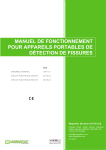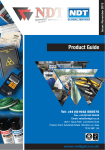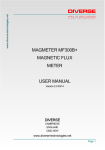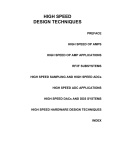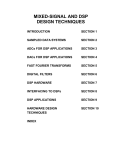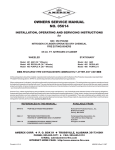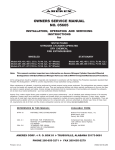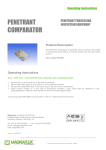Download P920 Operators Manual - Dec 11
Transcript
OPERATING MANUAL FOR PORTABLE CRACK DETECTION UNITS P920 GENERAL ASSEMBLY 15071.A1 ELECTRICAL CIRCUIT 220/240V 23130.A3 ELECTRICAL CIRCUIT 380/415V 23129.A3 Magnaflux (Division of ITW Ltd) Faraday Road, South Dorcan Industrial Estate, Swindon, Wiltshire, SN3 5HE, UK +44 (0)1793 524566 [email protected] www.magnaflux.com 01/12/2011 OPERATING MANUAL FOR PORTABLES CONTENTS Introduction 1 Safety precautions 2 Installation 3 Identification of controls 4 Operation of unit 5 Servicing 6 Trouble shooting 7 Service and calibration 8 Spares list 9 OPERATING MANUAL FOR PORTABLES SECTION 1 INTRODUCTION MAGNAFLUX is a division of ITW Ltd., a subsidiary of Illinois Tool Works Incorporate of Chicago U.S.A. Magnaflux of Chicago, U.S.A. is also a member of ITW Group. MAGNAFLUX design and manufacture Non-Destructive Testing Equipment, Fluorescent Penetrants, Contrast Penetrants and Magnetic Particle Materials in its 3500 square metre facility. MAGNAFLUX have over 50 years experience in the manufacture of NonDestructive equipment and materials. Our design team consider the equipment and materials described in this Manual to be the most practical for the inspection of your components, based on the information received. The design will ensure reliable results and durability, with minimum down time for service, thus giving a maximum return on your investments. The equipment is built in accordance with good machine tool standards and all components used will be entirely suited for their intended use. The equipment is built to MAGNAFLUX standards and practices. MAGNAFLUX is approved to ISO 9001. OPERATING MANUAL FOR PORTABLES SECTION 1 Magnaflux Warranty Agreement Your new Magnaflux product, when properly used, maintained and serviced should give years of excellent service. Magnaflux guarantees that its products will be free from defects in materials and workmanship for a period of 12 months from the date of invoice. This Magnaflux warranty covers only those defects which arise as a result of normal use of the product and not apply if the item has had :a) Improper or inadequate maintenance. b) Misuse or unauthorised modification. c) Operation outside capabilities. the products design This guarantee is in addition to and does not reduce your minimum statutory rights. OPERATING MANUAL FOR PORTABLES SECTION 2 SAFETY PRECAUTIONS In the interests of operator safety, the following points should be noted: DO NOT SMOKE WHILE PERFORMING NDT Read thoroughly the instructions given with the chemicals to be used and obey any warnings given Ensure that the equipment has a good ‘earth’ connection before first operation Wear safety glasses when operating the unit Never use the 108mm2 cable with damaged sheath exposing the wire Always isolate the unit before removing the cover for any reason Always use a good proprietary barrier cream on the hands to minimise skin irritation. The wearing of gloves is not recommended If the unit is protected by an earth leakage circuit breaker, check its operation by pressing the test button If an ultra violet lamp is used, be sure that:The filter glass is in place and is not cracked or damaged such that white light is emitted. After prolonged running the lamp housing gets very hot and can cause burning. Do not touch this lamp housing with unprotected flesh. The MAGNAFLUX Cool Running ZB100F reduces this risk. Do not, under any circumstances, shine the ultra-violet light into eyes. Direct viewing of the lamp may with certain people, cause irritation of the eye known as ‘Fluorescence of the retina’. Always wear UV absorbing spectacles. OPERATING MANUAL FOR PORTABLES SECTION 2 FIRE RISK Kerosene based carriers pose a very low risk under normal working conditions, however, kerosene will burn when subjected to sufficient heat such as may be generated by an electric arc. For this reason the following precautions are strongly advised: Do not use badly worn or pitted pistol prods Check that firm contact is made with the Component under test before initiating current flow Use a high-flash-point kerosene such as MAGNAFLUX Carrier II MAGNETIC FIELD RISK Persons susceptible to strong magnetic fields, including those with Pacemakers, are advised not to use or approach this equipment without seeking professional advice. AUDIBLE NOISE Unlikely to exceed 70dB(A) under normal operating conditions. OPERATING MANUAL FOR PORTABLES SECTION 3 INSTALLATION INSTALLATION SHOULD ONLY BE CARRIED OUT BY SUITABLE QUALIFIED PERSONNEL. These items of equipment are intermittently rated with a duty cycle of 10% e.g. 2 seconds on 20 seconds off, at maximum output. Model Number Magnetising Maximum Current Intermittent Output Output into 9mx108mm2 Cable P920 AC/HWDC 1500A Open Control Current Circuit Switch Drain Output Voltage from Voltage supply at Maximum Output Current 5 12V DC 55A @ 240v 30A @ 415v External Fuse Required 25A 16A AC current in RMS values HWDC current in MAGAMP values = 2 x MEAN VALUE THE MAXIMUM OUTPUT CURRENTS MUST NOT BE EXCEEDED. NOTE: a) USING A CABLE LENGTH LESS THAN RECOMMENDED IS LIKELY TO CAUSE THE UNIT TO EXCEED THESE FIGURES, AND POSSIBLE DAMAGE. Connect the integral lead of the P920 unit to a suitable electrical supply, see above for maximum current draw. Ensure the unit is PROPERLY ELECTRICALLY EARTHED. NOTE: b) To comply with BS6072 the unit should be protected by an earth leakage circuit breaker. Connect output cables to appropriate outlets at front of unit by pushing on and twist locking. Always utilise the ‘common’. OPERATING MANUAL FOR PORTABLES SECTION 4 IDENTIFICATION OF CONTROLS All controls are situated on the front panel Switches S1 - Selector Switch - Labelled AC / DC Function - This switch matches the ammeter to the output current selected (by choice of output connector) RV1 - Potentiometer - Labelled Min 1 - 9 Max Function - Controls the current level Lamps LP1 - Lamp - Labelled ‘Mains On’ colour White Function - Signifies mains power to unit Meter A moving coil meter is fitted to provide measurement of both AC and HWDC currents. AC current is calibrated in RMS (root mean square) HWDC current is calibrated in Magamps (twice mean) Both output currents are modified by the meter board which provides the means of calibration. Sockets SKT1 - This socket provides an inlet for the remote control lead for either the pistol grip prods or hand held push button OPERATING MANUAL FOR PORTABLES SECTION 5 OPERATION OF UNIT Check that the circuit breaker, on the side of the filter unit, is OFF Switch on the unit from customer’s supplied isolator The P920 ‘Mains On’ light will illuminate when circuit breaker is switched ON Prod Magnetisation Recommended cable lengths : 4.5 metres Attach two lengths of 108mm2 cable with either end to the common and AC or DC outlet located on the front panel. A prod unit should be attached to the other end of the cables. Plug the control cable of the prod unit into the SK1 socket Turn the current control Potentiometer to the required position. (Refer to NDT specifications for required values or British Standard BS0672. Experience will then dictate values required for standard parts.) Make prod contacts with a clean surface of the component. Place the prod tips approximately 150-200 mm apart on either side of the suspected defect. Press the prod handle switch to energise the unit and cause current to flow to the prod tips. The ammeter will indicate the magnetising current. Apply MAGNAFLUX dry powders using a dispenser, or spray on MAGNAVIS/MAGNAGLO ink while the magnetising current is flowing Release the prod switch to stop the magnetising current and remove the prods from the component Inspect the area for indications of defects using visible light for MAGNAVIS product or UV light for MAGNAGLO product NOTE: The prod method can be utilised with clamps or leeches, but it is necessary to substitute the hand held push button for the missing trigger switch on the Prod assembly. OPERATING MANUAL FOR PORTABLES SECTION 5 Coil Magnetisation Wrap a minimum of three turns of 108mm2 cable around or through the component to be inspected. Plug the ends into the common and AC or DC outlets. Plug the hand held push button (remote control lead) into SKT1 Turn current control Potentiometer to required position Refer to NDT Specifications for required values or British Standard BS6072. Experience will then dictate values required for standard parts. Press the hand held push button to energise the unit and cause current to flow. The ammeter will indicate the magnetising current. The current x number of turns = Ampere turns. Apply MAGNAFLUX dry powders using a dispenser, or spray on MAGNAVIS/MAGNAGLO ink while the magnetising current is flowing Release the hand held switch to stop the magnetising current Inspect the area for indications of defects using visible light for MAGNAVIS product or UV light for MAGNAGLO product. NOTE : If the wrap-round coil method is used it is possible to only magnetise in short lengths, for long components the coil will need to be spaced along the component, magnetising and inspecting for defects at each spacing. OPERATING MANUAL FOR PORTABLES SECTION 5 Demagnetisation Use the wrap around coil as before during coil magnetisation but this time only connect to the common and AC terminals. Plug the hand held push button (remote control lead) into SKT1. Turn current control Potentiometer to required position. Refer to NDT Specifications for required values or British Standard BS6072. Experience will then dictate values required for standard parts. Press the hand held push button to energise the unit and cause current to flow. The ammeter will indicate the magnetising current. The current x number of turns = Ampere turns. Press the hand held button and whilst the current is flowing, slowly separate the component from the coil by a minimum of 1 metre. Check the residual magnetism using a MAGNAFLUX Field Indicator Part Number 008M001 or 008M002. OPERATING MANUAL FOR PORTABLES SECTION 6 SERVICING THE FOLLOWING MUST ONLY BE CARRIED OUT BY SUITABLE QUALIFIED PERSONNEL. General The design of the equipment is such that only minimum of servicing is necessary. The frequency of servicing is dependent upon the nature and extent of work carried out. Obviously, if the equipment is engaged in the inspection of machined parts it will require less maintenance than if used for the inspection of rough castings, etc. Therefore, only an arbitrary guide is given for the intervals at which different items of the equipment are to be serviced. Inspection and Preventative Maintenance The following paragraphs describe the inspection and maintenance procedures for the unit. These instructions include periodic lubrication, inspection and cleaning, and the preservation of metal parts. Periodic replacement of assemblies or components as a preventative measure is not required. SILICON CONTROLLED RECTIFIER ASSEMBLY CLEANING. The silicon controlled rectifier assembly will gradually become coated with an accumulation of dirt and other airborne materials. As this coating builds up, the cooling effect of the rectifier assembly fans is reduced, and eventually the scr’s overheat. Inspect rectifier assembly every six months for accumulation of deposits. If the coating is excessive, clean the heatsink with compressed air at 25 to 40 psi and a soft brush. CAUTION: Do not clean the rectifier assembly with a cleaning fluid. GENERAL CLEANING. To prevent the excessive accumulation of dust and dirt as well as other such contaminants, thoroughly clean the equipment as required. No special cleaning procedures are required. However, a thorough cleaning in accordance with the following procedures is required to assure trouble free operation. WARNING: Use cleaning solvents in a well ventilated room. Avoid breathing the fumes and excessive skin contact with the solvents away from an open flame. When using compressed air, do not direct the air stream against skin. OPERATING MANUAL FOR PORTABLES 1. Electrical Parts. Minor cleaning, such as removal of dust and loose foreign particles can be accomplished by using a soft brush or lint-free cloth or by blowing out the dirt with dry compressed air at 25 to 40 psi. When using an air jet to blow off dirt and dust, either avoid or be careful when directing the air stream on delicate parts. To remove dirt, grease or oil from electrical parts, use isopropyl alcohol and apply with a soft brush. For best results, the cleaning agent should be applied at room temperature. It may be necessary to brush some parts vigorously with a stiff brush to remove hardened dirt particles. If possible, avoid excessive use of cleaning solvent on electrical insulating materials. After cleaning allow the cleaned parts to dry at room temperature for 10 to 15 minutes before operating the equipment. 2. Mechanical Parts. Clean mechanical parts by first removing dust and loose dirt particles with a brush, lint-free cloth or compressed air at 25 to 40 psi. Any accumulated dirt, grease or oil deposits that require further cleaning may be removed with a bristle brush or cloth moistened with a suitable solvent. After cleaning, allow the cleaned parts to dry at room temperature for 10 to 15 minutes before operating the equipment. INSPECTION. General Where there are no established wear limits, perform a visual inspection to locate worn and damaged parts which could cause improper functioning. It is recommended that mechanical and electrical inspection be performed on the assembled or partially disassembled equipment to determine the extent of disassembly required. In the absence of any special inspection requirements, operational tests are the most effective in isolating parts and assemblies requiring further inspection. 1. Check all wiring for discoloration, burnt insulation, breaks and security of connections. 2. Check the transformers for either an excessive wax deposit on the surface, discoloration, or a pungent odour, or the presence of phenolic resin. If in doubt the transformers must be checked by a Qualified Engineer. 3. Check terminal boards for broken or missing terminals and stripped threads. Check tightness of connections. 4. Check contactor contacts to determine whether silver has been worn away. The contacts are usable even though pitted, burnt or discoloured. They should be replaced only if the silver surface material has been torn away or completely worn off. The contacts are not to be dressed or filled in any way. OPERATING MANUAL FOR PORTABLES NOTE: Contact inspection necessitates removal of the contactor arc hood cover. 5. Depress and release contactor and relay armature and check for free operation with no binding. Depressing the armatures will require slightly more force since they operate against spring action to their normally-open or normally-closed positions. 6. Check the bus bars connections for tightness. Arcing and burn marks between mating bus bars indicates a loose connection. 7. Turn the cooling fan and check for free operation. The fan motor is permanently self-lubricated. Excessive binding necessitates replacement. Check the motor housing and fan blade for a dust and dirt build up. Use standard cleaning procedures and clean as require. 8. Check the “eitherend-connector” for discolouring, burn marks or splits. Replace them if damaged. Keep them clean for good contact. 9. Check the 108mm2 cables for splits and exposed wires. Repair with appropriate heat-shrink sleeving. 10. Inspect the Black Light assembly for missing of broken filter or lamp and the electrical leads for abraided or frayed insulation. Do not use electrical insulating tape to repair electrical leads but have them properly repaired or replaced. 11. Check lamps and meter for broken lenses and / or burned out bulb. Check all push button, toggle and selector switches for smooth and proper operation as appropriate. Operate the CURRENT CONTROL switch throughout its complete travel and check for smooth operation with no binding or erratic operation; check the control travel and function throughout its complete travel from minimum (off or 0) to maximum. 12. It is a legal requirement in many countries that the Electrical Safety of equipment is checked periodically, commensurate with use, but at least once each year. The basic tests required are to check the condition of effectiveness of the electrical Insulation and the continuity of the Protective conductor (earth). WARNING: DO NOT REPLACE ANY PARTS WITH OTHER THAN THOSE RECOMMENDED BY MAGNAFLUX. OPERATING MANUAL FOR PORTABLES SECTION 7 TROUBLE SHOOTING GUIDE THE FOLLOWING CHECKS SHOULD ONLY BE CARRIED OUT BY SUITABLE QUALIFIED PERSONNEL. Minor problem check list. a) Check the electrical supply and that the ‘Mains ON’ lamp is lit. b) Check the unit has not been overloaded and tripped out. c) Check for loose eitherend connectors. d) Check condition of prod tips. e) Check the P920 circuit board assembly by substituting a known working board. If a major fault occurs return to MAGNAFLUX for service and repair. OPERATING MANUAL FOR PORTABLES SECTION 8 SERVICE & CALIBRATION Manufacturers are being increasingly faced with demands by customers for certification relating to the conformance of their products to a specification. NDT products are no exception and require application of accurate measurements during manufacture in order to demonstrate assurance of conformance. The need for this assurance generally requires the manufacturer to process equipment that is capable of an accuracy higher than achieved in the product being certified. It is a legal requirement in many countries that the Electrical Safety of equipment is checked periodically, commensurate with use, but at least once each year. The basic tests required are to check the condition and effectiveness of the electrical Insulation and the continuity of the Protective conductor (earth). At MAGNAFLUX all our calibration equipment is tested and certified traceable to national standards. The department brings together the technical expertise, experience and calibration facilities typical of the market leader in NDT. OPERATING MANUAL FOR PORTABLES SECTION 9 Set of Recommended Spare Parts Holding for Two Years Part No: Description P920 002D045 Diode 3 001F062 Fuse 1A 2 009P040 Potentiometer 1 015S117 Switch AC / DC 1 13092 A3 Meter Board Assy. 1 15027 A3 Eitherend Connector 3 Prods & Cables 015S178 Prod Switch 1 025T008 Prod Tip, Mild Steel 4 1238 Eitherend connector 3

















